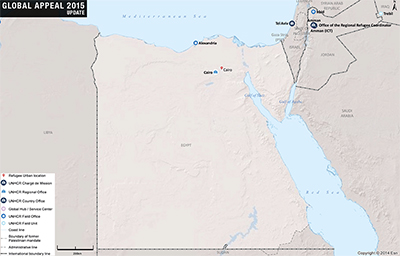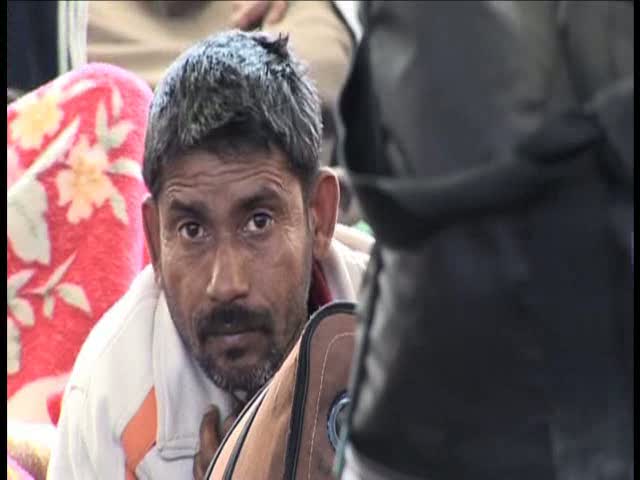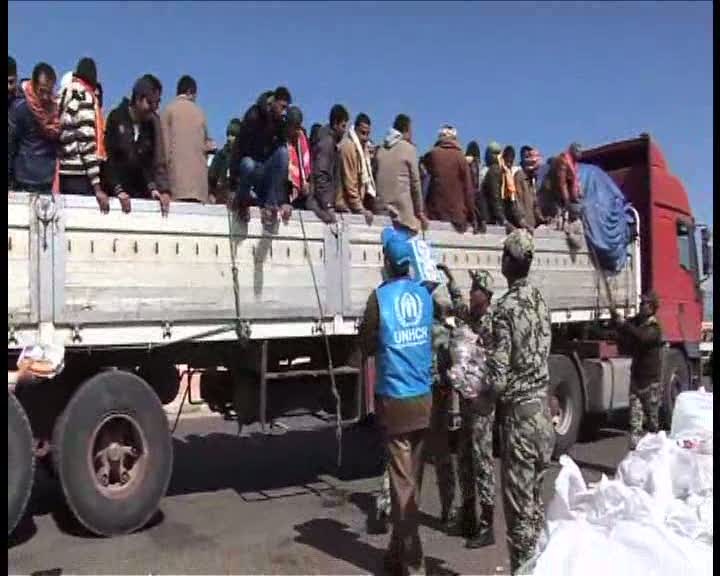Home > Where We Work > Middle East and North Africa > North Africa > Egypt
2015 UNHCR country operations profile - Egypt
| Overview |
Working environment
-
Egypt is a signatory to the 1951 Refugee Convention and its 1967 Protocol, and the 1969 OAU Convention. Nevertheless, as the country has not yet developed national asylum procedures and institutions, UNHCR carries out the functional responsibilities for all aspects of registration, documentation and refugee status determination (RSD) under the 1954 memorandum of understanding with the Government of Egypt.
-
Continued instability in Egypt has affected the protection environment for refugees and asylum-seekers and is likely to continue in 2015, with increased reliance on UNHCR for assistance programmes and protection interventions, including for legal residency and against arbitrary arrest, deportation and harassment.
-
While the Government grants some access to public primary health care and education, specialized public care for chronic illnesses and rehabilitative interventions is not available to people of concern, nor are various national public insurance schemes. The absorption capacity in state schools remains an issue due to overcrowding and teacher shortages.
-
In a strained political and socioeconomic environment, where refugees and asylum-seekers are finding it difficult to make ends meet, Egypt is likely to see a growing number taking risks to reach Europe via sea, through smuggling and trafficking networks.
-
An increasing number of asylum-seekers from South Sudan and Sudan have been registered by UNHCR in Egypt.
-
The Office has reached an agreement with the Egyptian authorities on the transfer of several hundred refugees and asylum-seekers from Salloum Camp (near the Egyptian-Libyan border) to Cairo, pending departure for resettlement or other durable solutions.
People of concern
In 2015, the main groups of people of concern to UNHCR are refugees from the Syrian Arab Republic (Syria) and other refugees and asylum-seekers in urban areas, including: Sudanese who escaped violence in various regions of Sudan; South Sudanese fleeing the latest internal conflict that began in December 2013, as well as those who have been in Egypt for decades; Somali refugees who fled the security situation in their country; Eritrean refugees who sought asylum due to human rights abuses or forced conscription; Ethiopian refugees who have fled political persecution; and Iraqi refugees.
| UNHCR 2015 planning figures for Egypt | |||||
|---|---|---|---|---|---|
| Type of population | Origin | January 2015 | December 2015 | ||
| Total in country | Of whom assisted by UNHCR |
Total in country | Of whom assisted by UNHCR |
||
| Total | 267,820 | 197,820 | 250,600 | 179,600 | |
| Refugees | Somalia | 6,300 | 6,300 | 7,000 | 7,000 |
| Sudan | 15,000 | 15,000 | 19,000 | 19,000 | |
| Syrian Arab Rep. | 140,000 | 140,000 | 120,000 | 120,000 | |
| Various | 79,600 | 9,600 | 82,200 | 11,200 | |
| Asylum-seekers | Ethiopia | 2,900 | 2,900 | 2,810 | 2,810 |
| Somalia | 1,800 | 1,800 | 1,400 | 1,400 | |
| Sudan | 15,500 | 15,500 | 12,060 | 12,060 | |
| Various | 6,700 | 6,700 | 6,100 | 6,100 | |
| Stateless | Stateless | 20 | 20 | 20 | 20 |
| Response |
Needs and strategies
In 2015, UNHCR will focus on providing protection for refugees and asylum-seekers living in Egypt by: conducting registration on an individual basis, according to UNHCR standards; undertaking RSD; and pursuing durable solutions where feasible.
Protecting refugees from violence and exploitation, particularly by enhancing sexual and gender-based violence (SGBV) response measures, will be a priority objective for the Office.
Moreover, given the challenging protection and operational environment, UNHCR will continue working closely with legal partners in 2015 and put particular emphasis on advocacy and communication to prevent a further deterioration in the way people of concern are perceived.
Throughout the year, together with the concerned authorities, the organization will work to prevent refoulement, raise issues related to arbitrary detention and ensure due process of law for crime victims among the refugee population.
UNHCR, with its partners, will financially assist the most vulnerable refugees and strengthen livelihoods activities and microfinance schemes targeting this group in particular.
The organization will also maintain its government training programme, enlarging the target audience to include the Ministry of Foreign Affairs and the Ministry of Social Solidarity in policy discussions.
| Implementation |
Coordination
UNHCR will continue to work closely with the Refugee Affairs Department of the Ministry of Foreign Affairs and the Ministry of the Interior, as well as with other line ministries.
It will maintain its close partnership with international and national NGOs, and also pursue efforts to diversify its local partners. The organization will expand cooperation with the main universities in Cairo, and continue working closely with other UN agencies and the League of Arab States.
| 2015 UNHCR partners in Egypt |
|---|
| Implementing partners |
| Government agencies: Ministry of Education |
| NGOs: Arab Council Supporting Fair Trials and Human Rights, Arab Medical Union, Arab Organisation for Human Rights, CARE International - USA, Caritas Egypt, Catholic Relief Services, Egyptian Foundation for Refugee Rights, Mahmoud Society, Refuge Egypt, Resala Charity Organisation, Save the Children, Terre des Hommes |
| Others: American University in Cairo, British Council, Psycho-Social Services and Training Institute in Cairo, Souriyat Association, Tadamon, UN Habitat, UNDP, UNFPA, UNICEF, UNOPS, UNV |
| Operational partners |
| Government agencies: Ministry of Foreign Affairs (Refugee Affairs Department), Ministry of Housing, Ministry of the Interior, Ministry of Local Development, Ministry of Social Solidarity, Ministry of Youth and Sports, Ministry of Education |
| NGOs: AMERA Legal Aid |
| Others: Baladilab Studio, FARD Foundation, International Development Support and Consulting, IOM, Man Ahyaha, OCHA, Oecumene Studio, Sacred Heart Church, St. Andrew's Refugee Services, Takween Integrated Development, WFP, WHO |
| Financial information |
Over the last two years, the Egypt operation's budget has steadily increased following the influx of Syrian refugees. The comprehensive needs for 2015 are estimated at USD 85.2 million.
Ongoing developments in Iraq and Syria may affect these financial requirements in the course of 2015 in light of current assessments of needs of people displaced by the conflicts in these countries. Any changes in requirements will be presented in the 2015 Regional Refugee and Resilience Plan (3RP) for the Syria situation or in a supplementary appeal for the Iraq situation.
Source: UNHCR Global Appeal 2015 Update
UNHCR contact information
| The UNHCR Representation in Egypt | |||||||||||||||
|---|---|---|---|---|---|---|---|---|---|---|---|---|---|---|---|
| Style of Address | The UNHCR Regional Representative in Egypt | ||||||||||||||
| Street Address | 17th Mekka El Mokrama Street, 3rd proximity , 7th District ., Behind 6th of October Club ., 6 October City - Egypt, Cairo, Egypt | ||||||||||||||
| Mailing Address | 17th Mekka El Mokrama Street, 3rd proximity , 7th District, 6 October City, Cairo, Egypt | ||||||||||||||
| Telephone | 20 2 383 57 509 | ||||||||||||||
| Facsimile | 20 2 383 55 762 | ||||||||||||||
| areca@unhcr.org | |||||||||||||||
| Time Zone | GMT + 2 | ||||||||||||||
| Working Hours |
|
||||||||||||||
| Public Holidays | 07 January 2016, Coptic Christmas 01 May 2016, Easter Coptic 02 May 2016, Sham El Nessim 06 July 2016, Eid Al-Fitr 07 July 2016, Eid Al-Fitr 11 September 2016, Eid Al-Adha 12 September 2016, Eid Al-Adha 02 October 2016, Higira Day 11 December 2016, Prophet's birthday 25 December 2016, Christmas Day |
||||||||||||||











































































